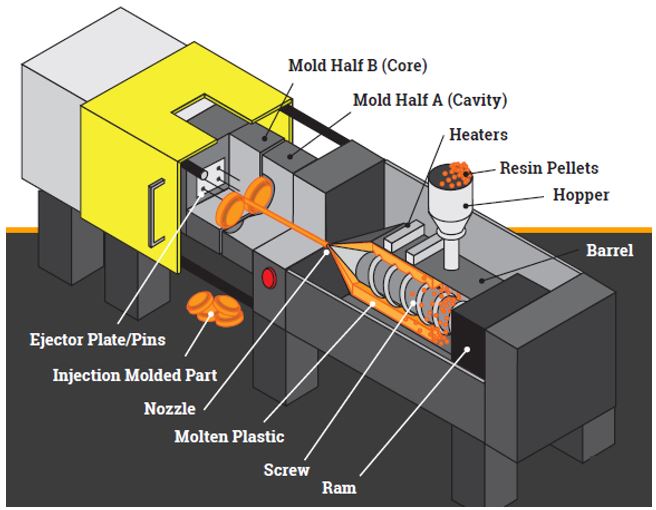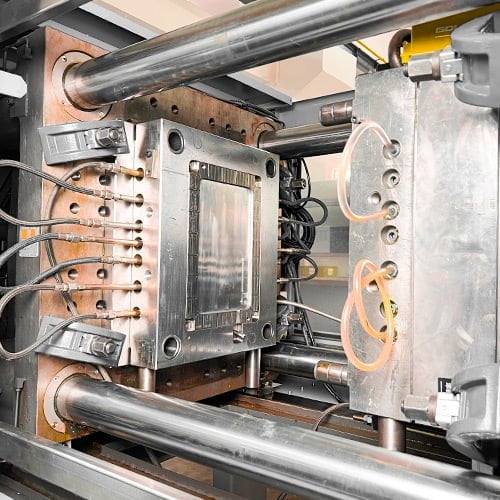Why Plastic Injection Molding Is Crucial for Precision and Resilience
Why Plastic Injection Molding Is Crucial for Precision and Resilience
Blog Article
Comprehending the Basics of Plastic Shot Molding Processes
Plastic shot molding offers as a keystone of contemporary production, giving a systematic technique to producing complicated components with accuracy. Exploring these essential aspects might reveal exactly how even minor modifications can lead to significant enhancements in production results, raising questions concerning the potential for technology in this well established procedure.
What Is Plastic Shot Molding?
Plastic shot molding is a commonly utilized production procedure that transforms thermosetting and polycarbonate materials right into specific and complex shapes. This technique is preferred for its capacity to produce high volumes of similar get rid of remarkable accuracy, making it a crucial approach in numerous markets, consisting of vehicle, durable goods, and clinical tools.
The process entails melting the chosen plastic material and injecting it into a mold and mildew under high stress. The mold, created to the specs of the preferred component, allows the molten plastic to materialize as it cools down and solidifies. As soon as the product has hardened, the mold and mildew is opened, and the completed part is expelled.
Plastic injection molding provides several benefits, consisting of decreased waste, uniformity in manufacturing, and the capability to include complex layouts that might be testing with other producing methods. Additionally, it supports a wide variety of products, each supplying distinct residential or commercial properties that can be customized for specific applications. As sectors continue to innovate, plastic injection molding continues to be at the leading edge, enabling the advancement of advanced items that meet advancing customer demands.
The Injection Molding Refine
The shot molding process is a sophisticated method that entails several crucial stages to produce top quality plastic components. Plastic pellets are fed into a warmed barrel where they are thawed right into a thick fluid. This molten plastic is after that infused under high pressure right into a precision-engineered mold and mildew, which shapes the material right into the wanted type.
As soon as the mold and mildew is filled up, the plastic is allowed to strengthen and cool, taking the form of the mold cavity. Cooling time is important, as it influences the cycle time and the last buildings of the shaped part. After sufficient cooling, the mold and mildew opens, and the finished component is expelled utilizing ejector pins.

Materials Utilized in Injection Molding
Numerous materials can be used in the shot molding procedure, each offering one-of-a-kind residential or commercial properties that provide to certain applications. One of the most generally made use of products include thermoplastics, thermosetting plastics, and elastomers.

Thermosetting plastics, like epoxy and phenolic resins, undertake a chemical change during the healing process, causing a rigid, inflexible framework. These materials are ideal for important link applications requiring high warmth resistance and architectural honesty, often utilized in electric insulators and auto parts.
Elastomers, consisting of silicone and rubber-based products, supply adaptability and strength. Their distinct residential properties make them appropriate for applications that demand elasticity, such as gaskets and seals.
Additionally, specialized products like bio-based plastics and compounds are getting traction for their environmental advantages and improved performance characteristics, expanding the extent of shot molding applications in numerous sectors. Understanding the residential or commercial properties of these materials is important for choosing the proper kind for particular projects.
Benefits of Shot Molding
Injection molding stands out as a very reliable production process that provides numerous benefits for generating complicated components with precision. One of the most considerable benefits is the capacity to produce intricate styles that would be challenging or difficult to accomplish with other approaches Discover More Here (Plastic Injection Molding). The procedure permits for in-depth attributes and limited tolerances, making sure high-quality parts
Additionally, shot molding is recognized for its rapid production capacities, making it an ideal selection for high-volume manufacturing. Once the mold and mildew is developed, components can be created quickly, lowering preparations and increasing general efficiency. This effectiveness not only decreases manufacturing costs but also supplies an one-upmanship look at this now in the marketplace.
The versatility of materials made use of in shot molding even more improves its appeal. A large range of thermoplastics and thermosetting polymers can be used, permitting producers to select materials that best satisfy their certain requirements, including versatility, stamina, and heat resistance.
Moreover, the procedure lessens waste, as excess material can commonly be reused and reused. This sustainability aspect adds to a reduced ecological effect, making injection molding an accountable production option. Generally, the benefits of injection molding make it a recommended approach for numerous industries.
Variables Impacting Product High Quality
While various elements can affect product high quality in shot molding, understanding these elements is crucial for achieving ideal results. Trick facets include product selection, processing criteria, and mold layout.
Product selection plays an important function, as various polymers display special residential or commercial properties that impact flowability, stamina, and thermal stability. Poor product choice can cause flaws such as bending or insufficient filling.
Processing criteria, consisting of cycle, pressure, and temperature time, need to be meticulously regulated. Variants in these setups can lead to disparities partly measurements and surface coating. Exceedingly high temperature levels might create destruction of the polymer, while insufficient stress can result in brief shots.
Mold design is similarly vital, as it determines the circulation of the molten plastic and the cooling process. Poorly created molds might lead to uneven air conditioning prices, resulting in recurring tensions and dimensional inaccuracies.

Conclusion
To conclude, plastic shot molding acts as an important production procedure that enables the reliable production of premium parts. Proficiency of the injection molding procedure, consisting of the understanding of products and the influence of different factors on item top quality, is important for attaining optimal results. The benefits of this method, such as cost-effectiveness and layout adaptability, additional underscore its significance throughout multiple industries, strengthening its condition as a favored choice for high-volume production.
Plastic injection molding serves as a keystone of modern production, giving a methodical strategy to generating complicated components with precision.Plastic injection molding provides numerous advantages, including lowered waste, uniformity in production, and the capacity to integrate complex styles that might be testing with other producing techniques (Plastic Injection Molding). As industries proceed to introduce, plastic injection molding continues to be at the forefront, enabling the development of innovative items that satisfy progressing customer needs
The injection molding procedure is an innovative technique that includes several vital stages to create premium plastic parts.In final thought, plastic shot molding offers as a critical manufacturing procedure that enables the efficient manufacturing of top quality elements.
Report this page